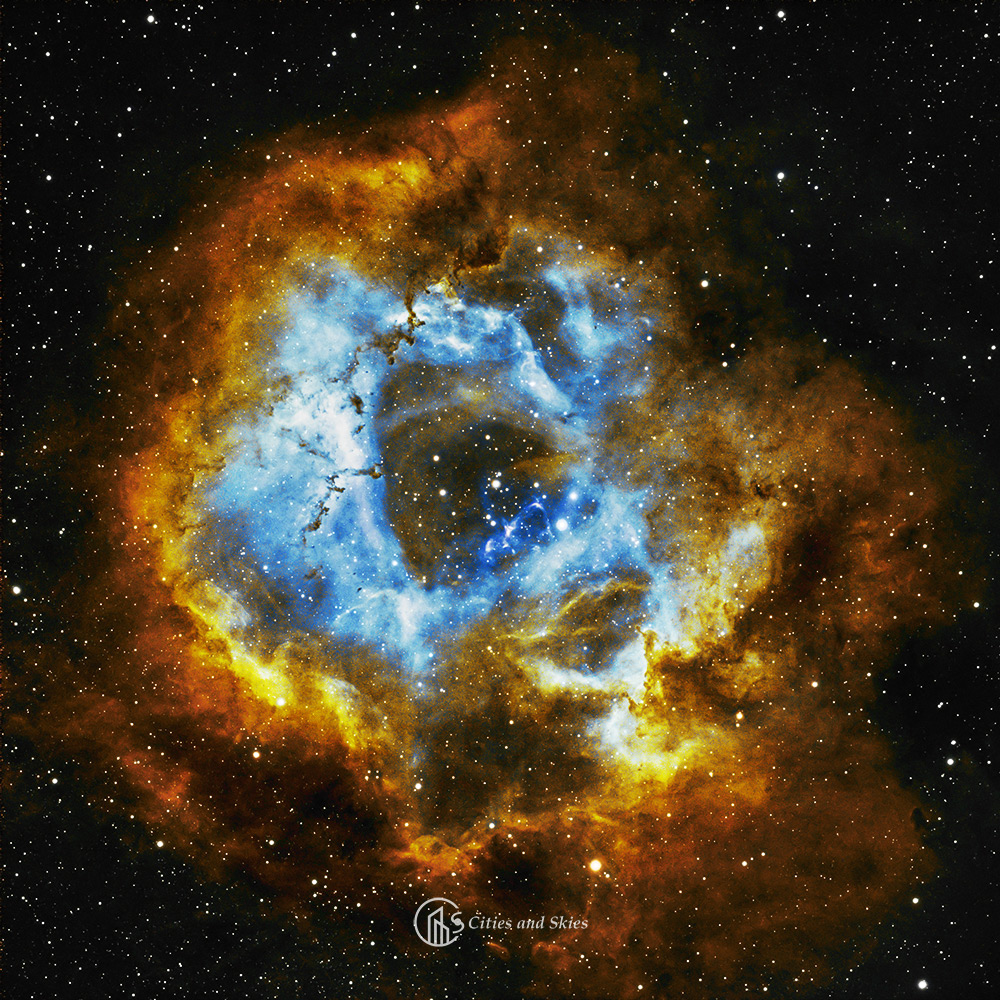The Rosette Nebula is an H-II region in the constellation Monoceros. The nebula is associated with an open cluster whose stars light up the nebula. The Rosette Nebula is an immense nebula, some three times larger than the Orion Nebula and three times farther away.
The night of 19 December 2020 was very special because it was finally clear skies, following weeks of cloudy nights. Suddenly, we found ourselves very busy. It was just a few days before the top astronomy event of 2020, the Great Conjunction of Jupiter and Saturn. Therefore we started right after sunset and took pictures with our camera. After that, we turned the telescope to the Moon and looked through it with our own eyes for the first time with the brand new eyepieces we bought from Ganymedes. Then we installed our camera with the regular (broad-band) light pollution filter setup. Our first target was the Seven Sisters since it had been so long on our bucket list.
Rosette Nebula, our first emission nebula
But there was a much greater challenge during that long night. Our Optolong L-eXtreme narrow-band filter has also arrived. This one is special because it allows capturing light only in the very specific flavors of colors emitted by ionized hydrogen (Ha) and oxygen (OIII). There are two main advantages of using this filter. Firstly, interstellar gas is very rich in these compounds. Secondly, using this filter truly minimizes light pollution from city lights in general. As a result, Galactic nebulae emitting light at these specific colors will just pop in the images!
We soon realized that preparations with this filter (like focusing the telescope) require boosting the camera sensitivity to near the maximum. To bring out the faint details in the short time available, we used this high sensitivity camera mode for the imaging as well. Since we were truly amazed by the lovely image of the Rosette Nebula by one of our astrophoto “mentors”, Paul Muskee, we decided to go with that one.
We were not really sure of what we may expect. But when we saw the first picture from just a few minutes of capture, we were jumping up and down. The beauty of the Rosette Nebula took our breath away. The level of details was staggering! Our imaging session went very well, but we could only collect about 2 hours of useful data before the target got too low on the horizon. We have seen some mysterious artifacts in the following images, perhaps due to street light getting in the camera through the fans in the back at this position.
An image of the cradle of stars
The true fun came afterward: image processing. The images had to be stacked and stretched in intensity levels. Otherwise, very few alterations were needed to make a natural-looking image. We however decided to learn the trick of making a false-color image. The reason is that this has the potential of highlighting details even further. One of these techniques mimics the color palette used by the Hubble Space Telescope.
We have struggled for a long time understanding how this works. Eventually, we came up with something similar, but slightly different. Our experimental method brings much more dynamics to the image. To do this, we used only the extreme blue end of the spectrum to represent the OIII-part of the image. It had to be strongly stretched and noise-reduced though, to get the desired effect. While this method enhances color contrast between the Ha and OIII-dominated regions, it makes the image noisier as well so one has to be careful.
We find the result mind-boggling! This nebula hosts hundreds of stars in the process of making, deep under dark globules of dusty clouds. While the already developed young, massive stars heat the gas to million degrees of Kelvin and blow it outwards – also causing shocks that form curvy ridgelines. All this comes to life in a single, swirling image, taken from the periphery of a quiet Dutch town. The town that prepares for the new year, which will hopefully put an end to the months-long misery of the COVID-19 epidemic.
Technical data
NGC2244 Star cluster + nebula, 30x300s (didn’t use last five)
Hoogeveen, Netherlands
Saturday, 19-20 Dec. 2020
William Optics GT81, f/5.9
Flattener 6AIII 0.8x
ZWO ASI533MC-P, gain 240, -20 deg.
WO Uniguide 50/200 with ASI120MMmini
iOptron CEM40
Optolong L-eXtreme
ASIair
Bortle~5
Moon 27%
ASTAP, StarNet++, Photoshop
